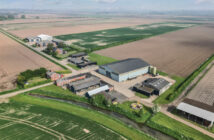Group 4 soft winter wheat LG Spotlight is the best looking wheat crop on Banchory Farm, near Kircaldy in Fife this year, says farm manager Craig Norrie, and he is so pleased with how it is looking that he is entering it into the Yield Enhancement Network (YEN) 2020 competition.
This will be Mr Norrie’s third entry into YEN; last year his Zulu crop recorded a total yield of 13.1t/ha, achieving 77% of the grain’s potential yield.
Participants into the YEN receive a full set of metrics on the performance of the entrant’s crop, which they can then compare with other YEN crop entries. Mr Norrie finds this a very valuable exercise and also an opportunity to discuss learnings with other growers.
The reports also help growers optimise their grain quality, for example Mr Norrie identified from the grain analysis in the first year’s report that there was not enough sulphur in the fertiliser, which he then adjusted last year.
He also highlights that because of the competition, he has a greater appreciation of the importance of organic matter (OM) in the soil. Analysis shows his farm has a good level of organic matter in its soils, which he attributes to 20 years of following a strong rotation and his cultivation strategy. He min-tills two years in a row for winter oilseed rape, and follows by first wheat, and then ploughs for spring barley.
“When we started to follow this approach, we were not thinking of organic matter, so it was interesting to learn that we are helping our land, and this gave us a real confidence boost.”
YEN 2020
LG Spotlight stood out in Mr Norrie’s on-farm trials last year. “Excellent yields of 11.32t/ha, superb grain quality and Hagberg from the large plots, highlighted LG Spotlight as a serious contender, “explains Craig.
He picks the top three varieties grown in his trials, growing 15-20ha of each, and the following year, the highest yielding one is grown across the whole of the farm.
On this basis, he drilled 15ha of LG Spotlight between the 28-30th October, into a field of medium to heavy loam, using a seed rate of 200kg/ha. “It was really wet by then, and my agronomist wasn’t sure if I should go ahead and drill, but we persevered, and the LG Spotlight didn’t let us down. Its vigour and ability to get away was astounding – a very valuable attribute, when conditions were as challenging as they were last autumn,” he says.
Mr Norrie has been using variable rate P, K and lime since 2008 and, as part of his normal agronomy strategy, the LG Spotlight received 1750litres/ha of liquid N in three applications.
To push his crop as hard as possible for the competition, he plans to give it a final dose of foliar spray of N.
The first fungicidal spray was applied at GS31; decisions for the remainder of the spray programme will be made according to the season and disease pressure.
With a good start behind it, the wheat is now looking well with little disease, he reports.
“There’s no doubt LG Spotlight has set a new standard for soft wheat grain quality, its excellent grain quality with a specific weight of 77.9kg/hl, and Hagberg Falling Number (HFN) of 288, whilst also producing high yields, are key to the growing popularity of the variety,” says Douglas Bonn of Nickerson Seeds.
It is this grain characteristic that makes it popular with both growers and the distilling markets, he adds.
Ron Granger, Limagrain’s arable technical manager confirms this; “LG Spotlight has similar physical grain quality characteristics as Group 1 & 2 quality wheats; an unusual combination in a soft wheat.”
He points out that LG Spotlight bucks the trend that soft wheats tend to have a HFN in the low 200’s or below; LG Spotlight with a HFN of 288, is well ahead, and is the highest available of all the soft wheats on the AHDB 2020/21 Recommended List.
“This, combined with the fact it is one of the best varieties available for sprouting resistance on the AHDB RL 2020/21, makes LG Spotlight very different from the rest – giving growers valuable grain characteristics for allowing harvesting flexibility and yield security.”
Mr Norrie agrees, pointing out that in a ‘catchy’ season when you have to decide which field to harvest first, the stability of the quality in LG Spotlight means that you can keep it on hold for a few days, which helps spread your risk and workload.
Douglas highlights that one of the grandparents of LG Spotlight is the firm favourite, Istabraq, and it would appear some of the grain quality attributes have been passed down.
Similar to Istabraq, LG Spotlight performs well in a second wheat position. This position in the rotation requires a variety to have exceptional grain quality, and the ability to perform under less than ideal conditions, he says.





